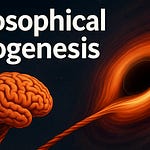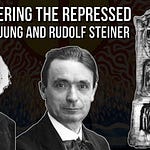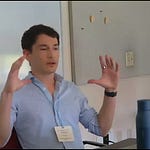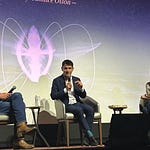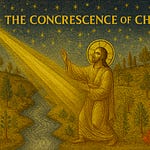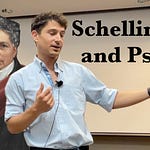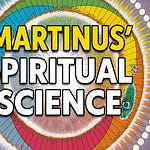Tomorrow, I’m talking to the philosopher of physics Ruth Kastner, who has developed the Possibilist Transactional Interpretation of quantum physics. I’ve also been talking to the developmental biologist Michael Levin. Both of them are exploring the space of possibilities in different ways—Ruth from a quantum physical point of view and Mike from a morphological, developmental biology point of view. In both physics and biology, science is beginning to wander into a new kind of territory.
But it is no longer a spatiotemporal sort of territory. It’s not even measurable. It’s a “space” of possibility—if you can even call it a space. Maybe topos or extensive continuum is a better term. It’s not measurable; it’s not a Euclidean space, and it’s not in any higher-dimensional sort of geometrical space either. It’s some other kind of reality. It is not material—it’s mental. Or at least, that’s the philosophical direction I would say this sort of inquiry is inevitably headed. And I think both Ruth and Mike are comfortable acknowledging that this continuum of possibility is “where” minds hang out, where intelligences and agencies live.
Crucially, this realm of possibilities is constantly transacting with the space-time realm of actuality. We already live in both of these realms. So don’t think of “quantum land,” as Ruth calls it, or Mike’s “Platonic morphospace,” as being somewhere else. No, we’re in it. Each and every thought, each and every movement that you make, that you are, is right at the interface of these two realms. Really, what exists is the interface, the interplay, the transaction between possibility and actuality. Neither one exists independently of the other, now or ever.
So, when we’re doing science—when we’re trying to know nature—we have to take a few things into consideration. First of all, while actuality and possibility are inseparable, part and parcel of the same process, they’re nonetheless related asymmetrically. This is because there’s an irreversibility to the creative process. The interplay between possibility and actuality is going somewhere. It’s a creative advance.
And so, when we consider scientific knowledge in this context, what does it mean to know ontologically? Not just what are the conditions of the possibility of knowledge, but what must the cosmos be, what must being be, in order for knowledge to be possible? And I think, to begin to answer that question, we have to start with perception. We have to perceive, and then try to describe what’s going on as we do so.
Some would say perception is always of the past. That’s just a fact of physics—because of the finite speed of light, the finite speed of causality. What our retinas receive, what our brain processes, is something that has already occurred external to us. We receive light, sound waves, or other kinds of vibrations from the environment: those vectors of energy take time to travel through space and then take time to be interpreted by our nervous system. So, in this sense, we’re always perceiving the past.
That would be the more realist perspective, at least. Even if we’re not perceiving what’s happening out there now, simultaneously with our experience in here now, we are at least perceiving what did happen out there in the past.
But then, there are also the predictive processing approaches—an alternative way of thinking about perception—which suggests that, no, we’re not perceiving the past, we’re perceiving the future. Or rather, our prediction of the future. This is more of an anti-realist position, or at least, it considers the real potentiality of our environment in a different temporal direction.
As those who listen to and read my stuff can probably guess, I think we need to bring these two perspectives together. There is a sense in which what we perceive is what we expect to perceive, but there is also a sense in which what we perceive is what has already occurred in the environment around us. And the distinction between these two—between expectation and reception—is, classically, the distinction between mind and matter.
Matter is what is in the past. Mind is what is in the future. But they’re not separate. They’re just poles, held taut across what can appear to us like an interdimensional rift but what is really just a difference in degree or intensity.
If perception has to be understood both in terms of a vector out of the past and a vector into the future, then knowledge is time-situated. We must recognize the time-developmental context in which knowledge is possible.
We’re always situated. There will always be something more that comes after us that we can infer something about but not everything. And there is always something that has come before us—and to know it is really a kind of memory. But not just a personal memory—a cosmic memory, a cosmic anamnesis. Cosmology is in this sense an attempt to recollect the prior stages of the universe’s evolution—the same stages that produced us, that gave rise to us as perceiving, conscious beings.
Gaining true scientific knowledge of the universe means remembering how we came to be who and what we are. The problem with scientific materialism and standard Big Bang cosmology is that they describe the evolution of the universe as if consciousness was incidental.
Now, maybe you can construct some kind of “as if” approximation of the universe without us by leaving consciousness out. But scientific materialism constitutively elides the “as if” hypothetical nature of such approximations. In reality, consciousness does exist. It is the only reason there is such a thing as science to begin with! Life and mind did in fact evolve on this planet. The universe is not simply physics (or if it is then physics must have been already pregnant with life and mind).
To understand the history of the cosmos as if it only had an outside—as if there was no inside—is not just leaving out half the picture. It’s distorting the whole picture. Because the inside is where the knowing happens, where agency happens, where decisions occur, where value is harvested and enjoyed.
As Whitehead would say, actual occasions of experience ingress eternal objects—potentials that lure actuality forward. Again, there’s always this interplay between actuality and possibility. These aren’t two separate realms; they’re two intensities of one reality.
There is a dipolarity to reality that throws the universe into forward motion, that allows for history, for evolution, for irreversible creative becoming. It’s not an eternal return. There aren’t a finite number of positions that the bits of the universe can take. There is open-ended transformation. No two moments are ever the same. Nothing ever repeats.
And yet, knowledge is possible. So there is some degree of definiteness to things. There is something that can be recognized as recurring across occurrences—but only as an abstraction. Concretely speaking, no two moments are identical. But abstractly speaking, we can identify recurring patterns.
That’s why scientific knowledge is possible. But it’s always a knowledge situated in time—it’s always caught between time zones, inheriting a past and anticipating a future.
When we talk about the continuum of possibilities—whether in morphogenesis, where cellular collectives harvest the latent potentiality that haloes their biochemical activity, or in physics, where atoms become excited and try to figure out where to send their photons—there’s always a transaction occurring, a relation unfolding with determinate actualities.
While it sounds odd at first, it is important to note that this transaction is not happening in an already constituted space-time. Quantum transactions do not involve some kind of retrocausality, where absorbers are sending signals backwards in time to emitters. Nor are emitters capable of precognition. It’s more like a quantum entanglement of intentionality, a synchronicity. It’s the universe deciding, microcosmic moment by microcosmic moment, the most efficient, least-action pathway forward.
There’s a basic tendency toward beauty—mixed with stochasticity, chaos, and chance—that gives rise to endlessly complex forms at varying scales of the cosmic fractal. That’s why we’re here. And our knowledge of the fact is our resonance with and prehension of the same quantum patterns that made and are making us.





